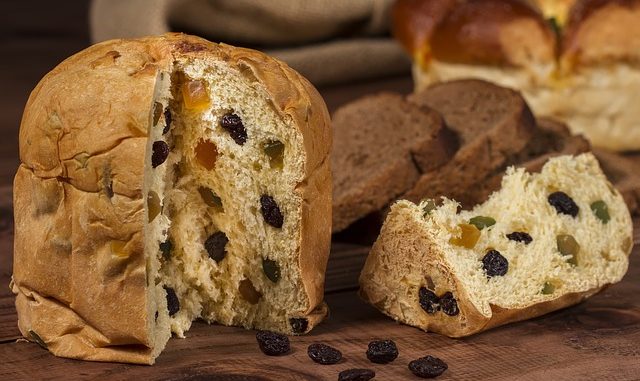
Panettone is the traditional Italian bread cake with candied peel and other fruit. It is usually eaten at Christmas and on other festive occasions. It’s often found with many variations and most retailers try to outdo themselves with the infinite variety of flavours and fruit. The recipe is for a traditional type.
The vanilla is important – an extract is more often used but if the bean paste is available then go for it.
[Please note we are an affiliate marketing partner and will make a sales commission if you purchase any items through our affiliate links. Please read our affiliate disclosure].
Equipment:
- Large pudding bowls
- kitchen foil
- kitchen oven
- kitchen tongs
- pastry brushes
- Electric whisks or hand whisks
- panettone mould
- Saucepans
- Wooden spoons
Ingredients:
- 4 tbsp warm full-fat milk
- 2 * 7g sachet of fast-action dried yeast or 25g fresh yeast from the bakery counter in large branches of Waitrose, Sainsbury’s, various health food shops or good bakeries.
- 150g caster sugar or golden caster sugar
- 250g salted butter, softened plus extra to grease. If you use unsalted butter then a pinch of salt will need to be added.
- 5 medium eggs, lightly beaten, plus 1 egg white for glazing if required or 2 large eggs with 5 egg yolks for a slightly heavier but richer panettone – it is less wasteful with the initial addition.
- 1½ tsp vanilla bean paste or 2 tsp vanilla extract
- grated zest of 1 lemon
- grated zest of 1 large orange
- 500g – 550g strong white bread flour, plus extra for dusting
- 85g raisins
- 85g sultanas
- 3 tbsp dark rum, spiced rum or golden rum,
- pinch of nutmeg (optional)
- 100g high quality candied lemon and orange peel, finely chopped
- Pearl sugar or icing sugar for dusting (pearl sugar, also known as sugar nibs, sanding sugar or sugar sprinkles), these types are found at Waitrose
- A good pinch of sea salt.
Preparation:
- Grease either a panettone tin or a 20cm deep loose-bottomed cake tin, or a panettone case.
- Beat the eggs including yolks if used.
- Stir the vanilla bean paste or vanilla extract into these beaten eggs.
- In a large bowl, beat the butter and nearly all of the sugar with an electric whisk for 5 minutes until light and pale, thickened and creamy. Leave a teaspoon of sugar for the later stage of feeding the yeast.
- Gradually add the beaten egg mixture a little at a time, whisking continuously until it is all incorporated. If the mix begins to curdle, add a spoons worth of the strong bread flour and beat with the eggs.
- Whisk in the zest of the orange and lemon.
- Warm the milk in a saucepan until tepid, then pour it into a small bowl. Crumble over the dried or fresh yeast, then add 1 tsp of reserved sugar. Stir until the yeast has dissolved, then set aside for a few minutes until the yeast activates and froths the milk.
- Sift the flour into a large bowl. Add that pinch of sea salt (or just salt) and nutmeg. Make a well in the centre and add the milky yeast and quickly mix through the flour. Add the whisked butter and egg mixture, folding in with a large spoon/spatula to make a soft, sticky dough.
- On a floured surface, knead the dough for between 5 and 10 minutes until it comes together, silky and smooth. The dough will initially be very sticky but by working it with floured hands and on a lightly floured surface, it will eventually form a firmer, more pliable, stretchy and dough that can be handled properly. Putting flour hands on the hands helps stop the mixture sticking but don’t overdo this.
- Form into a ball, then place in a lightly floured or lightly greased bowl and cover with cling film. Leave in a warm place such as an airing cupboard is ideal for 1½ hours or until doubled in size. The alternative if you haven’t time to bake is to place in the fridge overnight to prove.
- Meanwhile, place the raisins and sultanas in a small saucepan with the rum, bring to a simmer and heat gently for 5 minutes. Stir well so the fruit can absorb the rum and become plump and juicy. Remove from the heat and set aside to continue swelling up as they cool.
- When the dough has risen, tip onto a lightly floured surface. Knead for a few more minutes, then begin to knead in the soaked raisins, sultanas and chopped up candied peel until evenly distributed. Form the dough into a smooth ball and place it in your greased cake tin or panettone mould.
- If using a 20cm cake tin, wrap a layer of baking parchment around the outside of the tin, to come up about 5cm above the rim, and secure the paper with string. This will help contain the dough as it rises.
- Cover loosely with cling film. Leave to rise for between 2 and 4 hours in a warm place until the dough has doubled to tripled in size – the level of rise depends on how it has been kneaded before.
- Meanwhile, preheat the oven to either 200°C/fan180°C/gas 6 which is then lowered later on to 180°C/fan 160°C/gas 4. The alternative is to start at 180ºC/fan 160ºC/gas 4 — it all depends on what degree of bake is needed
- Adjust the oven shelf to the right height.
- When the dough has finally risen, either brush the top of the panettone with just egg white and sprinkle with the pearl sugar, if using. The alternative topping is to mix together almonds, caster sugar and egg white and gently brush that over the top of the panettone.
- Wrap a double layer of baking paper around the outside of the cake tin or panettone mould, high enough so it extends 10cm above the sides of the tin or mould. Secure with string.
- Place on a baking sheet and bake for 15 minutes if baking at the higher temperature and then reduce the temperature to 180°C/fan160°C/gas 4 and bake for 30-35 minutes more. If you bake at the lower temperature to begin with it will need just 40 to 50 minutes. Bake until golden. It’s ready when a skewer comes out clean when inserted into the middle of the cake. You may need to cover the top with foil after 20 minutes of cooking to prevent it browning too much.
- If your panettone is in a tin, cool for 5 to 10 minutes before turning out onto a wire rack to cool further. Otherwise, cool completely in the mould on a wire rack.
- Dredge or dust with icing sugar if you didn’t use pearl sugar. Slice into wedges and serve with a cup of espresso or a chilled glass of Vin Santo.

Leave a Reply